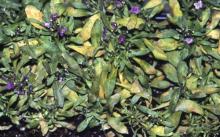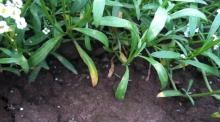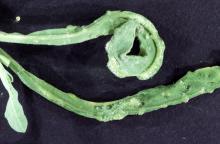Cause Hyaloperonospora parasitica (formerly Peronospora parasitica), a fungus-like organism. Downy mildew was first found in 1990 on Alyssum saxatilis in Oregon and sporadically since then. No written report exists for this disease in North America. P. galligena has been reported in Europe; however, the Oregon isolate agreed with the description for P. parasitica (Stone, Pscheidt, Fischer-unpublished.). Downy mildew outbreaks are not uncommon in alyssum seed production fields.
Symptoms Leaves are highly deformed ranging from puckered to curled. A whitish-to-grayish mycelial growth occurs in puckered areas on undersides of the leaves. This growth may look like salt sprinkled on the leaves. Plants are stunted and unsalable.
Cultural control
- Plant cultivars with lower susceptibility such as Easter Bonnet Pink.
- Remove and destroy infected plants.
- Isolate any new shipments from healthy plants. Inspect all plugs and cuttings for signs of infection.
- Keep humidity as low as possible with fans and venting. Irrigate when leaves will dry quickly.
- Maintain adequate fertility.
Chemical control Use before symptoms develop. Alternate or tank-mix products from different groups that have different modes of action.
- Aliette at 1.25 to 4 lb/100 gal water. Do not use with adjuvants. Group P7 fungicide. 24-hr reentry.
- Compass 50 WDG at 1 to 2 oz/100 gal water. Do not use organosilicate additives. Group 11 fungicide. 12-hr reentry.
- Fenstop at 7 to 14 fl oz/100 gal water. For greenhouse use only. Group 11 fungicide. 12-hr reentry.
- Fosphite at 1 to 2 quarts/100 gal water on 2- to 3-week intervals should be very effective for seed production. Start before disease appears in seed fields, shortly after stand establishment if conditions are rainy. Group P7 fungicide. 4-hr reentry.
- Heritage at 2 to 4 oz/100 gal water plus a non-silicone-based wetter sticker. Found to be effective in California trials. Group 11 fungicide. 4-hr reentry.
- Micora at 4 to 8 fl oz/100 gal water. Group 40 fungicide. 4-hr reentry.
- Orvego at 11 to 14 fl oz/100 gal water. Group 40 + 45 fungicide. 12-hr reentry.
- Phyton 27 at 1 to 2 fl oz/10 gal water. Group M1 fungicide. 48-hr reentry.
- Segovis at 0.6 to 3.2 fl oz/100 gal water plus another fungicide. Group 49 fungicide. 4-hr reentry.
- Stature SC at 6.12 to 12.25 fl oz/100 gal water. Group 40 fungicide. 12-hr reentry.
- Subdue MAXX at 0.5 to 1 fl oz/100 gal water. Group 4 fungicide. 48-hr reentry.
- Zonix at 45 to 76 fl oz/100 gal water. Can be sprayed on crop or injected into irrigation system. Short residual so may have to be used frequently for adequate results. 4-hr reentry.
Note: Copper-based fungicides have shown slight to moderate phytotoxicity and should be avoided; limited use in seed fields should not impact seed yields.
Reference Skrzypczak, C. 2006. Occurrence of downy mildews on ornamental plants and their control by chemical compounds. Communications in Agricultural and Applied Biological Sciences 72:801-804.





